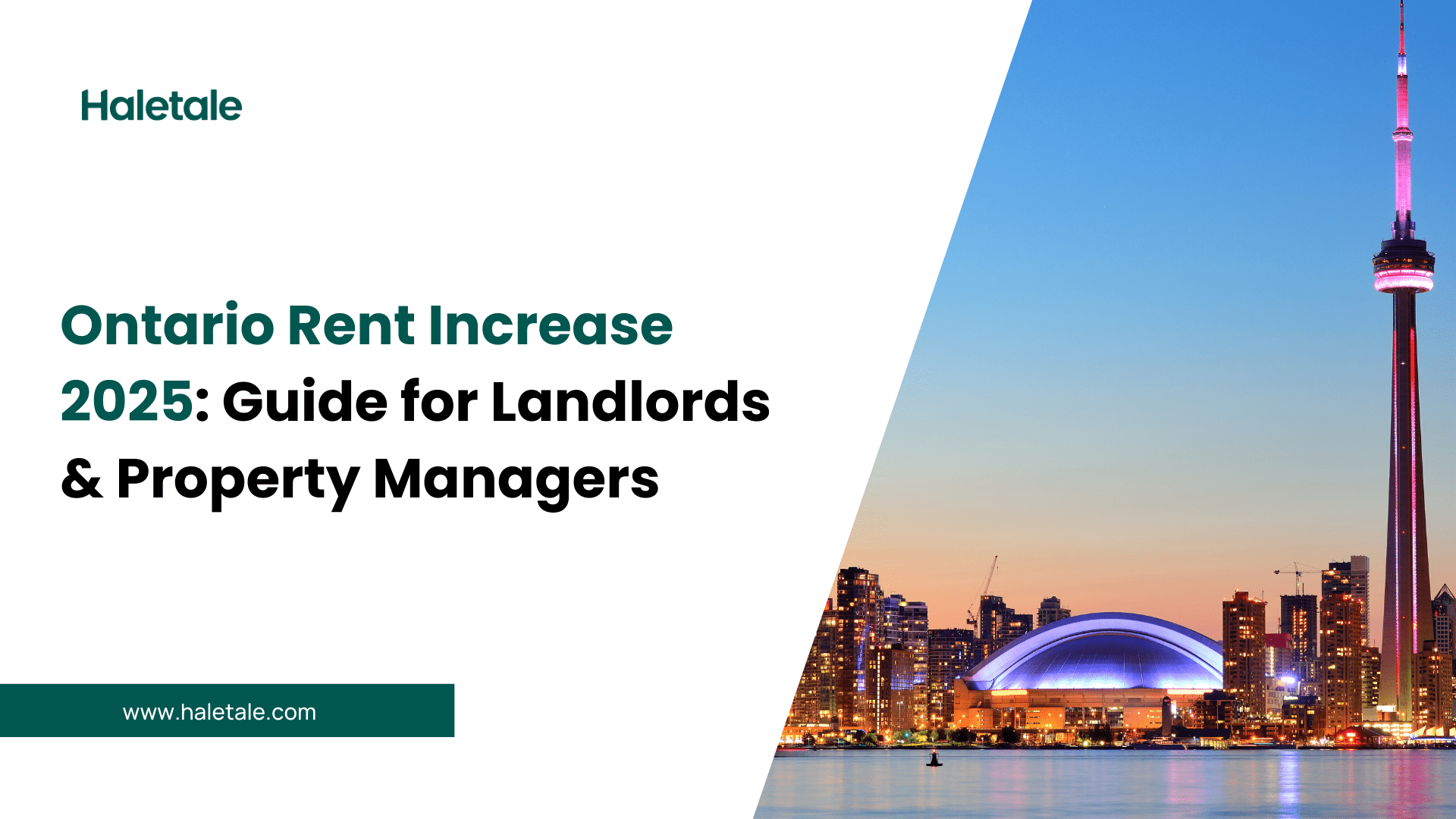Ontario Rent Increase 2025: Essential Guide for Property Managers and Landlords
Ontario has set the 2025 rent increase guideline at 2.5%, providing property managers and landlords with predictable parameters for rental income adjustments while maintaining tenant protections. This cap applies to most residential units built before November 15, 2018, with specific procedures and exemptions that every property manager must understand.
The Ontario rental market continues to evolve, and understanding the annual rent increase guidelines is crucial for property managers and landlords to maintain profitability while staying compliant with provincial regulations. The 2025 rent increase guideline of 2.5% represents a continuation of the province’s commitment to balancing tenant protection with reasonable returns for property owners.
Understanding the 2.5% Rent Increase Guideline
The Ontario government has set the rent increase guideline for 2025 at 2.5%, which is the maximum amount most landlords can increase rent during the year without approval from the Landlord and Tenant Board (LTB). This guideline applies to rent increases taking effect between January 1, 2025, and December 31, 2025.
The Ontario government calculates the rent increase guideline based on the Ontario Consumer Price Index (CPI), which tracks inflation by measuring changes in the costs of goods and services. However, the province has deliberately capped the increase below the current inflation rate to protect tenants from excessive rent hikes.
For property managers, this means that a unit currently renting for $2,000 per month can legally be increased to $2,050 per month—a $50 monthly increase. This represents a continuation of the same 2.5% limit used in 2024, providing consistency for long-term planning.
Historical Context: Rent Increase Trends 2020-2025
Understanding the historical context helps property managers better appreciate the current guidelines. The 2021 rent increase guideline was 0% due to a government-imposed rent freeze to help tenants during COVID-19. Since then, the guidelines have been:
- 2021: 0% (COVID-19 rent freeze)
- 2022: 1.2%
- 2023: 2.5%
- 2024: 2.5%
- 2025: 2.5%
- 2026: 2.1% (already announced)
In response to rapidly rising interest rates across the country, Ontario has decided to cap rent increases at 2.5% for 2025 below the 2.9% inflation rate. This decision reflects the province’s commitment to maintaining affordability while acknowledging the economic pressures facing both tenants and landlords.
Who Is Covered by the Rent Increase 2025 Guidelines?
The 2.5% guideline applies to most residential rental properties covered by the Residential Tenancies Act, 2006, including:
- Rented houses and apartments
- Basement apartments
- Condominiums
- Most multi-unit residential buildings
The 2.5% rent increase cap applies to the majority of rental units in Ontario, particularly those constructed before November 15, 2018. This includes approximately 1.4 million rental units.
Key Exemptions
Property managers must be aware of significant exemptions to the rent increase guidelines:
1. New Buildings and Units New buildings, additions to existing buildings and most new basement apartments that are occupied for the first time for residential purposes after November 15, 2018 are exempt from rent control. This means landlords of these properties can increase rent by any amount, though they must still follow proper notice procedures.
2. Vacant Units When a unit becomes vacant, landlords can set any rental rate for new tenants without restriction from the guideline.
3. Other Exemptions
- Long-term care homes
- Commercial properties
- Community housing (with different rules)
Essential Procedures for Property Managers
Proper Notice Requirements
The landlord must give a tenant written notice of a rent increase in the proper form at least 90 days before it takes effect. This is not negotiable—failing to provide proper notice can invalidate the rent increase.
Key Notice Requirements:
- Must use Form N1: Notice of Rent Increase (the official LTB form)
- Must be delivered 90 days before the effective date
- Can only be applied once every 12 months
- Must include specific information: current rent, new rent amount, effective date, and landlord signature
To illustrate, in case a landlord needs to raise the rent that will begin on May 1, 2025, the landlord is to file the notice to the tenant no later than January 31, 2025.
Documentation and Record-Keeping
Property managers should maintain comprehensive records including:
- Copy of the N1 form served to the tenant
- Proof of delivery (receipt, witness statement, or delivery confirmation)
- Date calculations showing the 90-day notice period
- Evidence of the 12-month period since last increase or tenancy start
Above-Guideline Increases (AGIs)
For properties requiring increases beyond 2.5%, property managers can apply to the LTB for Above-Guideline Increases under specific circumstances.
Qualifying Circumstances
A landlord can apply to the LTB for a rent increase that is above the guideline (AGI) amount for any of the following reasons: The landlord’s costs for municipal taxes and charges have increased by an “extraordinary” amount, or the landlord did extraordinary or significant renovations, repairs, replacements or new additions to the building or to individual units.
Property managers seeking to increase rent by more than 2.5% must submit an N10 form to the Landlord and Tenant Board for approval. The rent increase is still limited to 3% above the rent increase guideline – for 2025, that would be 5.5%.
Enhanced Documentation Requirements for 2025
Landlords seeking rent increases above the 2.5% guideline, typically due to significant capital repairs or increased operating costs face stricter documentation requirements in 2025. These include:
- Detailed receipts and contractor information
- Evidence that costs exceed depreciation
- Timeline documentation for completed work
- Proof of extraordinary expense circumstances
Current Market Conditions and Implications
The 2025 rent increase guidelines operate within a unique market context that property managers must understand.
Market Stabilization Trends
After seeing big rent increases in 2023, recent data shows that this rapid growth is slowing down. The latest reports reveal that the average monthly rent for an unfurnished one-bedroom unit in Ontario is now around $1,939. This is an increase of only 0.99% compared to the same time last year.
This stabilization presents both challenges and opportunities for property managers:
Challenges:
- Limited ability to increase rental income through rate increases
- Need to balance profitability with competitive positioning
- Vacancy rates in Toronto remain low, about 2.3 percent, meaning tenant demand is strong but new construction is slow
Opportunities:
- Focus on operational efficiency and value-added services
- Enhanced tenant retention becomes more valuable
- Strategic property improvements can justify above-guideline increases
Strategic Considerations for Property Managers
1. Revenue Optimization As the market shifts from quick price increases to slower growth, landlords need to find a balance. They want their properties to make enough money while still being competitive.
Property managers should:
- Apply the full 2.5% increase where market conditions support it
- Evaluate tenant retention costs versus turnover expenses
- Consider phased improvements that could qualify for AGI applications
2. Operational Excellence A cooling rental market means tenants have more choices. Landlords should make their properties more attractive by: Investing in Upgrades and Providing Excellent Service.
Focus areas include:
- Energy-efficient appliances and systems
- Enhanced security features
- Responsive maintenance and communication
- Digital amenities and services
Compliance and Risk Management
Legal Compliance Essentials
New legislation under Bill 227 empowers the Board to overlook procedural errors in applications if they are minor. This reduces technical barriers for landlords applying for higher increases, but those increases still require approval.
Despite these changes, property managers must maintain strict compliance with:
- Notice timing and format requirements
- Proper form usage (N1 for standard increases, N10 for above-guideline requests)
- Documentation standards for AGI applications
- Tenant privacy and entry regulations
Enforcement and Penalties
If a landlord attempts to impose an increase under any of these conditions, the increase is void, and the tenant is not required to pay it. Additionally, tenants can file applications with the LTB to recover illegally collected rent increases.
Property managers should be aware that wrongful eviction claims are being investigated more seriously by the Landlord and Tenant Board (LTB), especially in high-demand urban markets.
Technology and Process Improvements
Modern property management requires leveraging technology to ensure compliance and efficiency. Employ rental management software and market analysis tools to monitor performance, forecast trends, and make informed decisions.
Key technology considerations:
- Automated notice generation and tracking systems
- Tenant communication platforms
- Financial reporting and rent roll management
- Compliance monitoring and deadline tracking
Stay informed with industry updates: Property management regulations and market conditions change frequently. By subscribing to our newsletter, you’ll receive monthly updates every property manager should know about, including regulatory changes, market trends, and best practices for maximizing your rental property investments.
Looking Ahead: 2026 and Beyond
The rent increase guideline for 2026 is 2.1%, indicating a slight decrease from the current 2.5% level. This early announcement allows property managers to plan strategically for the coming years.
The downward trend suggests that the Ontario government is responding to stabilizing economic conditions while maintaining its commitment to affordability. Property managers should prepare for continued moderate increases and focus on operational excellence rather than relying solely on rent increases for revenue growth.
Conclusion
Ontario’s 2025 rent increase guideline of 2.5% provides a framework for property managers to maintain rental income growth while respecting tenant protections. Success in this environment requires understanding not just the percentage increase allowed, but the complete regulatory framework, proper procedures, and strategic considerations for long-term profitability.
Property managers who master these regulations, maintain excellent documentation practices, and focus on providing value to tenants will thrive in Ontario’s evolving rental market. For the most current information and forms, property managers should regularly check the official Ontario rent increase guidelines and LTB resources. The key is balancing compliance with strategic thinking, ensuring that every decision supports both immediate needs and long-term business objectives.
Haletale is a comprehensive Canadian property management software designed to streamline operations for property managers across Canada & US. Our platform helps ensure compliance with provincial regulations while optimizing rental property performance through integrated tools for tenant management, financial reporting, and regulatory compliance tracking.









